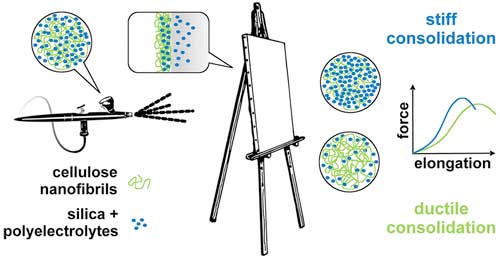| Posted: May 23, 2018 |
Preserving a painter's legacy with nanomaterials
(Nanowerk News) Paintings by Vincent van Gogh, Pablo Picasso and Johannes Vermeer have been delighting art lovers for years. But it turns out that these works of art might be their own worst enemy -- the canvases they were painted on can deteriorate over time.
|
|
In an effort to combat this aging process, one group is reporting in ACS Applied Nano Materials ("Combined Nanocellulose/Nanosilica Approach for Multiscale Consolidation of Painting Canvases") that nanomaterials can provide multiple layers of reinforcement.
|
 |
| The researchers propose an approach combining polyelectrolyte-treated silica nanoparticles (SNP) and cellulose nanofibrils (CNF) for canvas consolidation. CNF formed a film at the canvas surface that increased the ductility. SNP penetrated deeper and reinforced at the fiber scale, yielding higher stiffness. The two effects could be balanced by varying the SNP/CNF ratio to reach a suitable reinforcement. (© ACS)
|
|
One of the most important parts of a painting is the canvas, which is usually made from cellulose-based fibers. Over time, the canvas ages, resulting in discoloration, wrinkles, tears and moisture retention, all greatly affecting the artwork.
|
|
To combat aging, painting conservators currently place a layer of adhesive and a lining on the back of a painting, but this treatment is invasive and difficult to reverse.
|
|
In previous work, Romain Bordes and colleagues from Chalmers University of Technology, Sweden, investigated nanocellulose as a new way to strengthen painting canvases on their surfaces. In addition, together with Krzysztof Kolman, they showed that silica nanoparticles can strengthen individual paper and cotton fibers.
|
|
So, they next wanted to combine these two methods to see if they could further strengthen aging canvas.
|
|
The team combined polyelectrolyte-treated silica nanoparticles (SNP) with cellulose nanofibrils (CNF) for a one-step treatment. The researchers first treated canvases with acid and oxidizing conditions to simulate aging. When they applied the SNP-CNF treatment, the SNP penetrated and strengthened the individual fibers of the canvas, making it stiffer compared to untreated materials. The CNF strengthened the surface of the canvas and increased the canvas's flexibility.
|
| The team notes that this treatment could be a good alternative to conventional methods.
|

